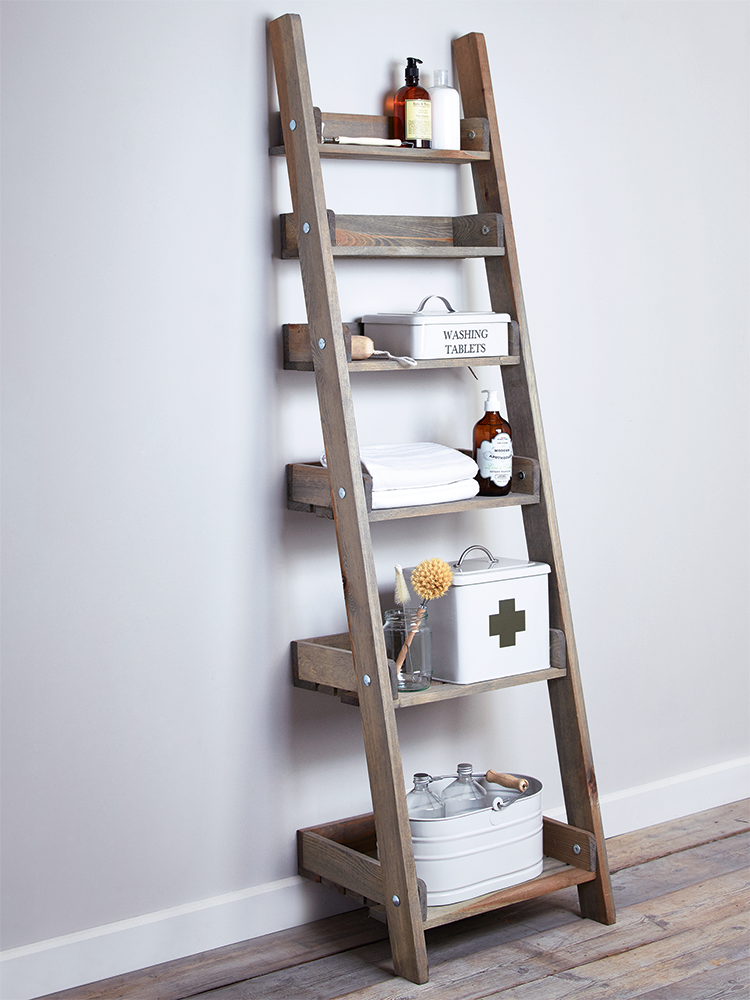
Once the piece has a good fit, use the crosspiece as a template to cut a second crosspiece for the remaining side assembly. If you’re a perfectionist like me, you’ll cut and trim these pieces a few times to get a perfect fit. Mark the angle along the front edge, and then cut the piece to size. Size the Remaining CrosspiecesĮlevate the assembled side on scrap blocks, and then slide a 1×2 under the frame, aligned with a mark for a shelf. To do so, hold a level against the outer edge of the back leg to check that it’s plumb-or perfectly vertical-and then set the level on the bottom crosspiece to ensure it sets level between the front and back leg. Check that the Side Sets LevelĪt this point, it’s a good idea to check that the assembled shelf side sets level. Apply glue to the ends of the crosspieces, and then secure them using a drill/driver and 1¼” pocket hole screws.
#STORAGE LADDER SHELF INSTALL#
Install the Top and bottom Crosspieces between Two LegsĪlign the top crosspiece with the top edge of the back leg, and the bottom crosspiece above the mark for the bottom shelf. Using a tape measure, speed square and pencil, mark the height of the shelves on the back legs at 6″, 20″, 34″, 48″ and 62″. We’ll fill the pocket holes in the top crosspieces after assembly, so the pocket holes can be offset, but the rest of the pocket holes should be located along the bottom edge of each crosspiece so that they will be concealed by the shelves later on. Prep a Top and Bottom Crosspieceĭrill a pocket hole at each end of a top and bottom crosspiece.

While I provided measurements for all of the crosspieces in my cut list below, I recommend cutting the top and bottom crosspieces to length, attaching them between the legs, and then cutting the remaining crosspieces to fit to ensure perfect joints. The sides are made up of a back 1×2 leg with two square cut ends, an angled front leg mitered at parallel 9-degree angles, and crosspieces that set horizontally at the height of each shelf with one square cut end and one mitered end meet the angle of the front leg.
#STORAGE LADDER SHELF HOW TO#
Follow the directions below to learn how to build a DIY ladder bookcase. Best of all, you can easily build your own for a third of the price you’d pay at the store. Wall mounting recommended not included with In-Home Delivery service.4 hours Steps for Building a DIY Leaning Ladder BookcaseĪ ladder bookcase is a great addition to any room. Top shelf weight limit 15 pounds, lower shelves 40 pounds. Minimalist design features elegantly shaped solid wood frames.Ĭombine wide and narrow units to perfectly fit your space. Small space-friendly open shelving solution. Wall mounting recommended (not included with In-Home Delivery service). Folk is available in two widths, making it easy to create a wall of storage to fit any space. Shelves are thoughtfully spaced and have thick solid wood front edges, which allow for sculptural details throughout. Ladder frames are made of elegantly shaped solid wood.


“We wanted to create a timeless shelving unit that you could afford for your first studio apartment and easily move around, add elements to and expand as your needs and spaces change throughout your lifetime,” explains Rønn. Folk Ladder Shelving (2017) is yet another reflection of that renowned quality, at once a celebration of minimalism and functionality. The sincerity of their approach – bypassing flashy design for good design – shows in the quality of their work. Danish designers Jonas Bjerre-Poulsen and Kasper Rønn named their company Norm to express their dedication to “working with Danish norms and standards refined over hundreds of years,” says Bjerre-Poulsen.


 0 kommentar(er)
0 kommentar(er)
